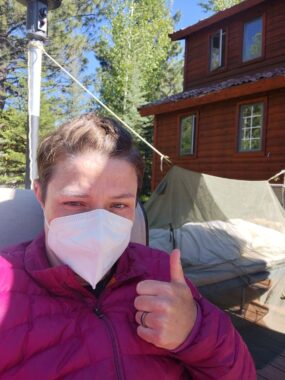My worst nightmare: I brought COVID-19 to my mom’s house
A columnist shares the precautions she took to avoid spreading COVID-19

Last April, COVID-19 took up residence in our house again — or so we thought. My husband, Jonny, had a raging set of symptoms, and I had a sore throat. Our at-home tests gave mixed results. After a week of quarantining, our PCR tests came back negative.
Negative? But I’d missed four days of work! I’d canceled plans! I’d written a column citing my COVID-19-induced angst! Worst of all, I didn’t get that sweet, sweet immunity boost that is perhaps the only silver lining of an infection.
And boy, do I wish I had.
Last month, I traveled to Alaska for a rugby tournament. The weekend was full of tough competition, team bonding, and socializing with new friends from all over the country. After three years of forced respite from competitive touring, I soaked up every minute of fun, including a night out on the town.
By the time I arrived at the Anchorage airport on Monday night for a red-eye flight to visit my parents, I had a tingle in my throat that made me speed-walk the entire terminal looking for an N95 mask in one of the shops. But I was out of luck and out of time to change plans.
After all the time and effort, the relationships strained, and tears spilled that went into trying to protect my immunocompromised mom, Holly, from COVID-19, I was headed straight toward her with a terrible lump in my throat. I felt like a time bomb.
I texted my mom to say I wasn’t feeling well and asked her to bring me an N95 when she picked me up. Then, I boarded the plane with my crappy polyester face mask and fell asleep before we even pulled back from the gate. I rarely sleep on planes, but I was dead to the world for eight hours, gate to gate.
When I landed in Reno, Nevada, I made a beeline for the bathroom and tore through my luggage for the rapid antigen tests I’d packed. My mom sat in the parking lot while I waited for results.
It was negative, but we acted like it wasn’t. I met her outside, skipped the hug, donned the N95 mask, and headed home.
After spending the day masked up with my parents, I drove south to see my best friend, Jen. I’d told her about my symptoms, but she welcomed me anyway. We spent three days together, during which I got progressively sicker.
On Friday morning, four days after my sore throat started, I finally tested positive for COVID-19. Cue the meltdown.
I was bound for my parents’ house that day, and while I was miserable and anxious, we had protocols in place to keep my family safe. Being my mom’s caregiver before and after her bilateral lung transplant in 2019 had prepared us for the pandemic.
Step 1: Give a damn
This is the most important part of preventing the spread of COVID-19. If you care about the people around you and treat everyone as if they’re immunocompromised, you’re probably already saving lives.
Step 2: Be prepared
I am quadruple vaccinated. I carry rapid antigen tests anytime I travel. I usually wear a KN95 mask on public transport, but, of course, the one time I really needed it, I didn’t have one. My fabric mask sufficed, but I won’t leave home without a higher-rated mask again.
I also knew about the COVID-19 hotline in my hometown and did a phone screening to see if I could get Paxlovid (nirmatrelvir and ritonavir) once I tested positive.
Step 3: Treat even the slightest indication of illness with the utmost caution
I had the most minor sore throat at the airport and treated myself like a walking biohazard. I immediately informed the people I was going to see and changed plans accordingly. Even though I tested negative right before seeing my family, I knew it wasn’t a free pass. I still behaved as though I’d tested positive.
Step 4: Isolate at whatever cost

Christie shows off her quarantine accommodations outside. (Photo by Christie Patient)
For me, that meant sacrificing personal comfort. I camped on my parents’ deck for a week. I endured two straight days and nights of pine pollen clouds, windburn, and temperatures in the 30s — terrible living conditions for someone with a gnarly chest cold.
I stayed out of the house — except for a designated sicko-only bathroom — for the better part of the week. Once I’d tested negative two days in a row, I eased up on my precautions.
If you’d rather pay for a comfier quarantine space, I don’t blame you. Get yourself a hotel room and have a staycation with room service and cable.
Step 5: Survive
Luckily for my conscience, no one I exposed before I tested positive got COVID-19. And because of our strict precautions at home, my parents also remained healthy.
Note: Pulmonary Fibrosis News is strictly a news and information website about the disease. It does not provide medical advice, diagnosis, or treatment. This content is not intended to be a substitute for professional medical advice, diagnosis, or treatment. Always seek the advice of your physician or other qualified health provider with any questions you may have regarding a medical condition. Never disregard professional medical advice or delay in seeking it because of something you have read on this website. The opinions expressed in this column are not those of Pulmonary Fibrosis News or its parent company, Bionews, and are intended to spark discussion about issues pertaining to pulmonary fibrosis.









Leave a comment
Fill in the required fields to post. Your email address will not be published.